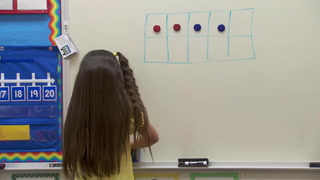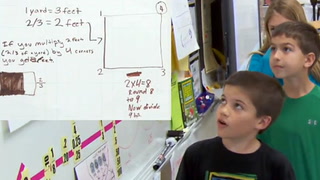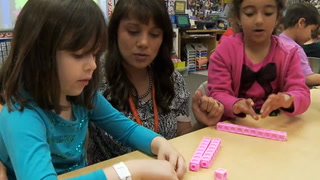Series AFT CCSS Math: Beyond Fingers: Place Value & the Numbers 11-19
Math.Practice.MP2
| Common core State Standards
- Math: Math
- Practice: Mathematical Practice Standards
-
MP2: Reason abstractly and quantitatively.
Mathematically proficient students make sense of quantities and their relationships in problem situations. They bring two complementary abilities to bear on problems involving quantitative relationships: the ability to decontextualize--to abstract a given situation and represent it symbolically and manipulate the representing symbols as if they have a life of their own, without necessarily attending to their referents—and the ability to contextualize, to pause as needed during the manipulation process in order to probe into the referents for the symbols involved. Quantitative reasoning entails habits of creating a coherent representation of the problem at hand; considering the units involved; attending to the meaning of quantities, not just how to compute them; and knowing and flexibly using different properties of operations and objects.
Math.Practice.MP3
| Common core State Standards
- Math: Math
- Practice: Mathematical Practice Standards
-
MP3: Construct viable arguments and critique the reasoning of others.
Mathematically proficient students understand and use stated assumptions, definitions, and previously established results in constructing arguments. They make conjectures and build a logical progression of statements to explore the truth of their conjectures. They are able to analyze situations by breaking them into cases, and can recognize and use counterexamples. They justify their conclusions, communicate them to others, and respond to the arguments of others. They reason inductively about data, making plausible arguments that take into account the context from which the data arose. Mathematically proficient students are also able to compare the effectiveness of two plausible arguments, distinguish correct logic or reasoning from that which is flawed, and--if there is a flaw in an argument--explain what it is. Elementary students can construct arguments using concrete referents such as objects, drawings, diagrams, and actions. Such arguments can make sense and be correct, even though they are not generalized or made formal until later grades. Later, students learn to determine domains to which an argument applies. Students at all grades can listen or read the arguments of others, decide whether they make sense, and ask useful questions to clarify or improve the arguments.
Math.K.NBT.A.1
Common core State Standards
- Math: Math
- K: Kindergarten
- NBT: Number & Operations in Base Ten
- A: Work with numbers 11-19 to gain foundations for place value
-
1:
Compose and decompose numbers from 11 to 19 into ten ones and some further ones, e.g., by using objects or drawings, and record each composition or decomposition by a drawing or equation (such as 18 = 10 + 8); understand that these numbers are composed of ten ones and one, two, three, four, five, six, seven, eight, or nine ones.
Drawings need not show details, but should show the mathematics in the problem. (This applies wherever drawings are mentioned in the Standards.)
Save to My Resources
PLEASE CREATE A NEW ACCOUNT OR LOG IN TO ACCESS THIS CONTENT
Enjoy your first video for free. Subscribe for unlimited access.
Have questions about subscribing?
Click Here to learn more about individual subscriptions.
Click Here to learn more about School and Institution access.
Discussion and Supporting Materials
Thought starters
- What does mathematical reasoning look like in kindergarten?
- How are students encouraged to share and learn from each other?
- What supports does Ms. Lassiter use to further her students' thinking?
School Details
Manatee Cove Elementary School734 West Ohio Avenue
Orange City FL 32763
Population: 706
Data Provided By:

Teachers
Karen Lassiter
Newest
|
4 MIN
|
5 MIN
|
5 MIN
UNCUT CLASSROOMS
| TCHERS' VOICE
English Language Arts














97 Comments
Avery Baird May 14, 2020 6:30pm
The idea of giving the kids manipulatives to work with and allow them to prove how they got the answer is a really great way for them to understand how they got the answer. Asking them questions about the magnets was a great way for them to use their knowledge to understand if the teacher added more or just moved the magnets around. Growing on a format they already know is good for the students because they are familiar with it but you can challenge them to build on their knowledge of the place value of the numbers 11-19.
Danielle Jarrett Mar 24, 2018 6:11pm
Mary Bartz Feb 9, 2018 6:29pm
jane lowe Aug 12, 2017 2:02pm
Diana Garcia Jun 14, 2017 1:18am